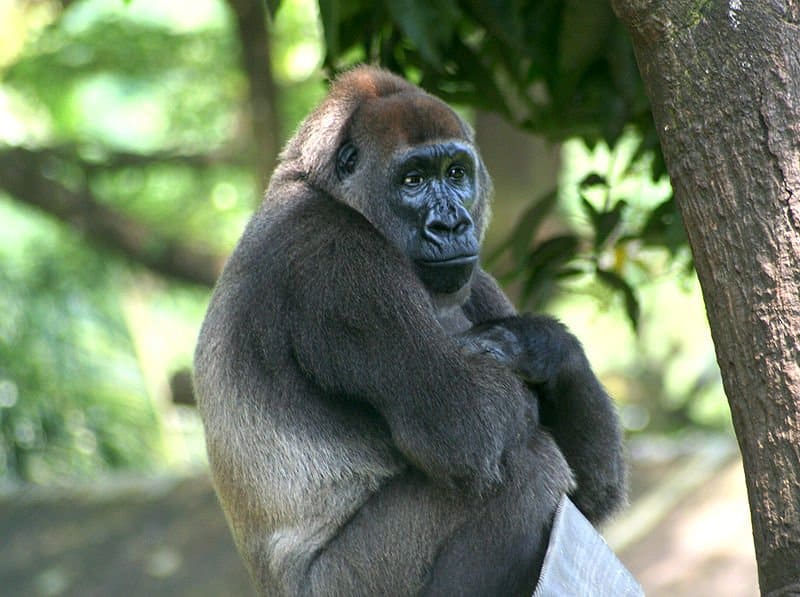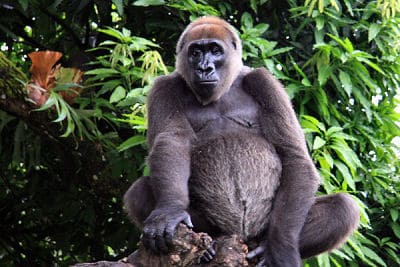Cross River Gorilla
Gorilla gorilla diehli
Less than 300 remaining!
Advertisement
Cross River Gorilla Scientific Classification
- Kingdom
- Animalia
- Phylum
- Chordata
- Class
- Mammalia
- Order
- Primates
- Family
- Hominidae
- Genus
- Gorilla
- Scientific Name
- Gorilla gorilla diehli
Read our Complete Guide to Classification of Animals.
Cross River Gorilla Conservation Status
Cross River Gorilla Facts
- Main Prey
- Leaves, Fruit, Flowers
- Habitat
- Rainforest and dense jungle
- Predators
- Human, Leopard, Crocodile
- Diet
- Herbivore
- Average Litter Size
- 1
View all of the Cross River Gorilla images!
The Cross River Gorilla lives in the mountainous region between Nigeria and Cameroon.
The Cross River gorilla (scientific name: Gorilla gorilla diehli) is a subspecies of the western gorilla. Paul Matschie, in 1904, named the cross river gorilla a new species, though it has become increasingly rare.
These gorillas have brownish-grey or black fur. However, the face, hands, and feet have no fur at all. They have cone-shaped heads, above which, rests a reddish crest. These gorillas are very social and usually live in groups of 2 to 20. The groups are led by a dominant male. Apart from the dominant leader, there are 6-7 females and their children.
Cross River gorillas sexually mature at age 10 and usually have babies every 4 years. Their gestation period usually lasts 9 months. These gorillas live in the mountainous region between Nigeria and Cameroon. The Cross River gorillas are herbivores and usually feed on branches, nuts, leaves, and berries that they hunt for from different plants.
The Cross River gorillas are known to be highly efficient in infant care and are known to care for their babies up until they are three to four years of age. During this time, they do not reproduce again and give their full attention to their newly born baby.
Incredible Cross River Gorilla Facts!
- Known as the world’s strangest gorillas, the Cross River gorillas are small in population and are rarely seen.
- Cross River gorillas are critically endangered – there are only 200 to 300 left in the world.
- They are the most endangered primate in Africa.
- They are usually found at the borders between Nigeria and Cameroon.
- Most of their day is spent eating.
Scientific Name
The Cross River gorillas go by the scientific name “Gorilla gorilla diehli” and belong to the kingdom Animalia and class Mammalia. They belong to the phylum Chordata and order Primates. They also belong to the family Hominidae and genus gorilla.
Evolution And Origin
The Cross River gorilla is a subspecies of the western gorilla, which scientists believed originated from a genus of proto-primates that were around at the end of the Cretaceous period. The first species of what we know of as Old World monkeys appeared about 40 million years ago. It is believed that the western species of gorilla deviated into its own genus during the Pleistocene era, and the cross river gorilla was further shaped into its own subspecies around 17,800 years ago due to climate change.

Appearance And Behavior
The Cross River gorillas have a slender yet short build, paired with light-colored hair. These gorillas have long arms and a prominent ridgeline, which offers a striking contrast to the flat face and wide nostrils. Their dark eyes are concealed by fur, which is often either black or brownish-gray.
The face usually has no fur, just like the hands, and feet. Their heads are cone-shaped, and they have a red-colored crest on their heads. The group leaders who are dominant males often have a silver patch on their backs – which is also why they are called silverbacks.
The Cross River gorillas are social and live in family groups of 2 to 20 individuals. Their behavior is very similar to other gorillas. The group is usually led by a silverback male as the dominant leader.
The male leader is usually responsible for taking care of the females and children of the group and also often makes the key decisions of the group like the feeding and nesting sites.
A group usually consists of the dominant male, six to seven females, and their children. The nesting happens in forests after these gorillas build nests with branches and leaves. The nesting places are usually on the ground.
However, the resting places change in the rainy season when they shift their nests to the top of trees. Most of their day is spent eating. However, sources suggest that they also indulge in recreational activities like grooming.
These gorillas are usually known to be peaceful. However, they may sometimes turn aggressive toward humans when threatened. They may attack humans with branches, stones, and herbs if provoked.

Cross River Gorilla is known to be peaceful.
©Kit Korzun/Shutterstock.com
Habitat
Known as the world’s strangest gorillas, the Cross River gorillas are small in population and are rarely ever seen. They are usually found on the mountainous borders of Nigeria and Cameroon. This habitat of theirs is called the Cross River basin.
These animals are known to inhabit most North and West regions. They also exist in the Afi mountains in Nigeria and the Cameroons’ Mbe mountains. Apart from that, they are also found in the Takamanda National Park of Cameroon and the Cross River National Park in Nigeria.
Most of these gorillas are found at a height of 1500 meters to 3500 meters in mountainous rainforests and bamboo forests.
Diet
The foods found in the diets of the Cross River gorillas mainly consist of leaves, nuts, berries, and liana which is a woody vine. These herbivorous gorillas will search as far as they need to go for their nutrients, even outside of their typical foraging area to get what they need.
If this gorilla species makes it down to the lowlands, they will likely find themselves in an unsatisfactory situation with local farmers that harvest bananas and plantains. Even though this may seem overwhelming to the area, some local farmers have remarked that they are far less destructive to their land than other animals with a smaller stature, including wild pigs.
The only way that Cross River gorillas seek out food in other areas is due to the lack of nutrition in proximity to their home. Still, the only time in recent history that these beautiful mammals have caused significant damage was in 2006. This event is believed to have been the result of how close the farms were to the forest homes of the gorillas.
Predators And Threats

Cross River Gorilla (Gorilla gorilla diehli) is threatened by hunters and is the most endangered great ape in Africa.
©Julielangford / Creative Commons – Original
Like all the other living beings on the planet, the Cross River gorillas are also an important part of the ecosystem. However, they also face a lot of threats – both from other animals and from human beings. The predators of the Cross River gorillas include crocodiles and large jungle cats.
The Cross River gorilla is threatened by humans as they were hunted extensively in the past – which is also why their numbers are pretty low. Human activities like deforestation also pose threats to these gorillas. The Cross River gorillas are the most endangered great apes in Africa.
The Cross River gorillas are critically endangered. As the population dwindles, some organizations are working to protect the forests that they live in, preventing them from venturing out into local areas and losing food sources. The World Wildlife Organization has multiple partners within the Nigerian and Cameroon governments to protect certain areas.
Reproduction, Babies, And Lifespan
The Cross River gorillas reach maturity around ten years of age. They usually give birth only once in four years or so because the level of infant care is very high in these Cross River gorillas. These gorillas usually take care of their babies until they are three or four years of age. The gestation period usually lasts about nine months – which is also very similar to humans.
The Cross River gorillas are polygamous animals. The dominant male of the group usually mates with all the sexually mature females of his group. The female gorillas, after giving birth, breastfeed their babies and take care of them up until they are about three to four years of age. Usually, these gorillas give birth to single babies and pairs are a rare occurrence. The lifespan of these gorillas is usually 35 to 50 years.
Population

Efforts are being made to have this primate live in protected environments, like the Limbe Wildlife Centre in Cameroon
Since these gorillas are critically endangered due to hunting and other human activities like deforestation, there are only about 200 to 300 Cross River gorillas left in the world. The majority of these gorillas are in Nigeria and Cameroon, spread out amongst no less than 11 families.
Efforts are therefore being made to make them live in designated places so that they could thrive in protected environments since the Cross River gorilla is decreasing still. Apart from their fragmented families, another trade has become highly lucrative and a major threat to the species – selling this species as pets.
Some people have kept the Cross River gorilla as pets, which is a dangerous trade that impacts the ability to conserve the species. Some hunters will kill the parent of the baby gorilla to take them to sell, as they are easy to handle at a small size. Right now, the threat of becoming infected with Ebola and of being hunted is enough to make recovery an impossibility in the short term. Still, there is hope that this species will recover from these threats within the next 75 years, as long as continued efforts are made to preserve their habitat.
In the Zoo
Due to the critically endangered status and the decreasing number of Cross River gorillas around the world, keeping them in a captive environment allows these gorillas can thrive again. To view them in a zoo, there are many reserves and sanctuaries to host them, like the Afi Mountain Wildlife Sanctuary.
The Limbe Wildlife Center in Cameroon has been the only zoo to have one of these gorillas on display since 2007. The gorilla, who was named Nyango, passed away on October 10th, 2016 as the result of illness, and there are no other reports of zoos that currently hold these mammals.
Despite not hosting these animals, many zoos and sanctuaries offer important facts about the Cross River gorilla to encourage patrons to support conservation.
View all 235 animals that start with CCross River Gorilla FAQs (Frequently Asked Questions)
What do Cross River gorillas eat?
Cross River gorillas are herbivores and feed on branches, leaves, nuts, and berries that come from several different plants.
Where does the Cross River gorilla live?
The habitat of the Cross River gorillas includes the mountainous forest between Nigeria and Cameroons. This space is called the Cross River basin.
Why is the Cross River gorilla endangered?
The Criss River gorillas are endangered mainly because they were victims of severe and aggressive hunting in the past few years. They have also been endangered because of human activities like deforestation. The Cross River gorillas are the most endangered great apes in Africa.
How many Cross River gorillas are left?
Due to aggressive hunting activities, there are only about 200-300 Cross River gorillas left in the world.
How long do Cross River gorillas live?
The Cross River gorillas usually live for 35 to 50 years.
Are Cross River gorillas carnivores, herbivores, or omnivores?
Cross River gorillas are herbivores and their diets usually comprise branches, leaves, nuts, and berries that they obtain from various plants.
Are Cross River gorillas aggressive?
The Cross River gorillas are usually peaceful animals. However, they can often turn aggressive towards humans and can also try to hit them with stones and branches.
What are the predators of the Cross River gorillas?
The Cross River gorillas are often eaten by crocodiles and large forest cats.
What Kingdom do Cross River Gorillas belong to?
Cross River Gorillas belong to the Kingdom Animalia.
What class do Cross River Gorillas belong to?
Cross River Gorillas belong to the class Mammalia.
What phylum to Cross River Gorillas belong to?
Cross River Gorillas belong to the phylum Chordata.
What family do Cross River Gorillas belong to?
Cross River Gorillas belong to the family Hominidae.
What order do Cross River Gorillas belong to?
Cross River Gorillas belong to the order Primates.
What genus do Cross River Gorillas belong to?
Cross River Gorillas belong to the genus Gorilla.
What type of covering do Cross River Gorillas have?
Cross River Gorillas are covered in Hair.
How many babies do Cross River Gorillas have?
The average number of babies a Cross River Gorilla has is 1.
What is the scientific name for the Cross River Gorilla?
The scientific name for the Cross River Gorilla is Gorilla gorilla diehli.
How fast is a Cross River Gorilla?
A Cross River Gorilla can travel at speeds of up to 25 miles per hour.
How to say Cross River Gorilla in ...
Thank you for reading! Have some feedback for us? Contact the AZ Animals editorial team.
Sources
- Wikipedia / Accessed November 30, 2020
- New England Primate Conservancy / Accessed November 30, 2020
- Gorillas World / Accessed November 30, 2020
- Cross Gorilla Programme / Accessed November 30, 2020
- WWF / Accessed November 30, 2020
- Study.com / Accessed November 30, 2020


















